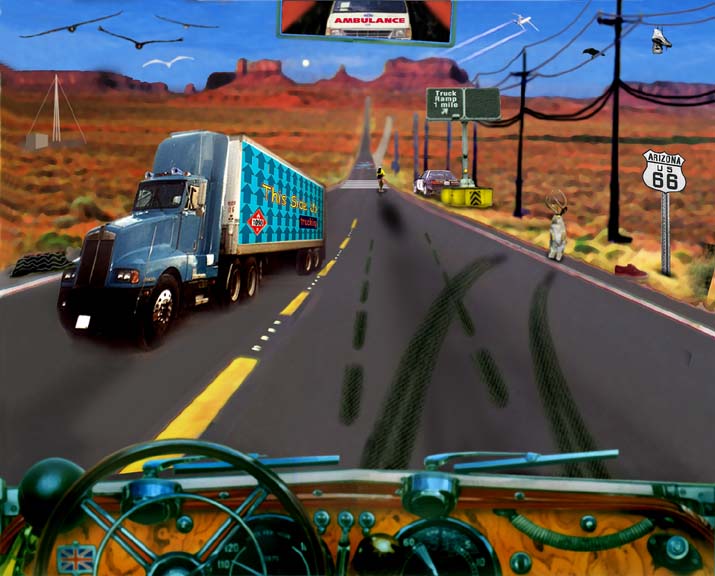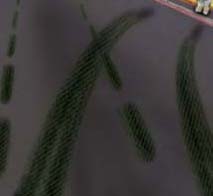
A Guide to science activities in your car.
Check out the new Klutz/Exploratorium Guide
by Paul Doherty, Pat Murphy, John Cassidy and the editors of Klutz Press.
The mathematics behind two of the activities in the book can be explored here:
You can also explore Frequently asked questions FAQ's, and the mathematics of car crashes and air bags.
Here is a sneak preview of one part of the guide. I assembled the following photomontage of science you can see from your car window.
David Barker used photoshop to create this image, the final rendition which appears in the guide was airbrushed.
Click on an object and learn more about it!

What do you see in this image?
![]()
Hazardous material number on truck: These tell emergency crews what to expect in an accident or spill. Here are some of the common or otherwise interesting numbers.
1005 ammonia
1013 Carbon Dioxide
1017 chlorine In case of spill, evacuate people within 1500 feet then
protect people within 4+ miles
1044 fire extinguishers
1046 helium
1056 krypton (superman beware!)
1072 gas oxygen
1073 liquid oxygen
1075 liquefied petroleum gas
1090 Acetone
1170 ethanol
1202 diesel fuel
1203 gasoline (with methanol)
1204 nitroglycerine (also 3064 in concentrate)
1210 printing ink
1228 mercaptan mixtures (essence of skunk)
1299 turpentine
1327 wet hay
1350 sulfur 2448 if molten
1407 cesium (explodes in contact with water)
1830 sulfuric acid
1953 compressed gas, flammable, toxic
1955 compressed gas toxic
1972 liquefied natural gas
1977 liquid nitrogen
1978 propane
1993 fuel oil, other flammable liquids, flammable liquid
cosmetics
1999 asphalt
2015 hydrogen peroxide
2017 tear gas grenades
2187 liquid carbonic, carbon dioxide
2188 arsine * poisonous clear people within 7 miles of the accident
site!
2794 car batteries filled with acid
2969 castor beans

Skid marks When drivers slam on the brakes the wheels on the car slow down and stop spinning, they drag along the asphalt rubbing off some of the tire and leaving a skid mark. Accident investigators use skid marks to read what happened in an accident, can you? They measure the length of the skid mark to figure out how fast the car was going before the brakes were applied.

Dashed skid marks: are made by cars with anti-lock brakes, these brakes pulse on and off quickly this allows the wheels to turn so that the driver can steer while making an emergency stop.
On cars without anti-lock brakes professional drivers pulse the brakes to allow the wheels to turn so that they can steer during an emergency stop. The dash marks made by drivers tend to be longer and less regular than those made by anti-lock brake systems.

Oil stains. Cars leak oil. I like to say that the first law of engineering is, "it leaks." These oil drips make a dark smudge down the middle of highways. Whoever, where there is a bump in the road, drips will be dislodges and fall in one place. This creates a larger, darker stain. Once you know this secret you can amaze your friends with your roadway ESP, you can predict bumps before you hit them. When you see a dark spot on the road, predict an upcoming bump.
To make a super sensitive bump detector just hold one arm straight out in front of you. It will bob up and down with the slightest bump.
![]()
Sand Barrels. To protect cars from collisions with solid objects, often highway crews place a line of sand barrels in front of the object. The sand barrels the car would hit first are only partially full of sand. The barrels further back in the line contain more and more sand. This brings the car to the most gradual possible stop. Even so the deceleration of a car going 60 mph when it hits a sand barrel system can be 5 g's. 5 times the acceleration of gravity.
![]()
Police Cars park by the side of the road and use Radar to measure the speed of passing cars. The radar gun puts out a microwave signal which bounces off the car and then is detected by the radar gun. When it bounces off the moving car the frequency of the radar is Doppler shifted. The gun measures the Doppler shift and displays the speed of the car.
![]()
Shoe bolo. Gauchos in Argentina use bolos, three rocks tied together with thongs to hunt animals, this is the classic American shoe bolo used to hunt wires.
![]()
Birds can sit on a single high voltage wire and not get electrocuted. However if the birds touch two wires or a wire and a pole a large voltage across their bodies will electrocute them. The bird shown is a raven. If it were to touch two wires it would perch here nevermore.

High voltage wires carry energy across the country.
They usually are arranged in groups of 3 each with its own phase of Alternating Current, AC.
The longer the insulator the higher the voltage. In most areas, if you count the insulator rings and multiply by 20,000 you can find the voltage of the wire. For example 1 insulator is 20,000 volts or less, 3 insulators 60,000 V, 6 insulators 120,000 V, 12 insulators 240,000 V, and 24 insulators 480,000 V.
In damp areas, for example near the ocean, electric utilities sometimes put on a double length of insulators, so you will over estimate the voltage. In foggy areas they use fog insulators which are larger in diameter than normal insulators.
Very rarely you will see pairs of wires with very long insulators these are Direct Current, DC, high voltage lines.
If you stand near high voltage lines you can hear hissing and crackling as some of the electric current leaks into the air around the wire.
The wires are not insulated, touch one while you are touching the ground, the pole or another wire, and you will die!
In lightning storm areas one or two wires run along above the power wires. These are lightning protection wires, and are connected to the ground below.

Heavy black cables not separated from poles by
long insulators are bundles of telephone wires.
Some towers also carry cable for cable television.

You can read the word ambulance in the mirror because it is written in reverse on the front of the ambulance. Look back and see that it says ECNALUBMA. When an ambulance is sounding its siren and flashing its lights, pull over and let it pass. Leonardo DaVinci wrote his notebooks in handwriting that was reversed, he could then read it in a mirror. This was a way to keep prying eyes from reading his work. He also wrote it in Latin which would have kept a lot of us from reading it even if it were not reversed.
![]()
Mirage. Sometimes patches of water appear on the road ahead. As you approach these patches they vanish! These are mirages. If there were water on the road it would reflect light from the sky like a mirror would. However hot air over the road can bend light from the sky into your eye by refraction. This looks just like a puddle of water, except the hot air can only bend the skylight a little. Thus, as you approach the patch of hot air it vanishes. My friend Jay Bolemon notes that the layer of hot air is very thin. The reflector dots and Botts dots stick up through the mirage showing that the hot air layer is thinner than the height of the dots, less than 1 cm thick.

Reflectors. The middle of the roadway is sometimes marked by reflectors. These reflectors send car headlights back toward the driver so that they show up as bright spots on the road during the night or in rainstorms. The dots are glued down to the roadway using epoxy resin glue. The glue is stronger than the roadway and you will sometimes find a dot that has been ripped from the roadway with the epoxy and a bit of the road still attached to the reflector.
In snow country the reflectors are placed down in grooves cut in the roadway. These grooves protect the dots from being scraped off by snow plow blades.
Yellow lines separate traffic moving in opposite directions, white lines indicate lanes for traffic traveling the same direction.
In general, you should not cross solid lines.
Chrome lugnuts on truck wheels hold the wheel onto the axle. Sometimes these lugnuts seem to be rotating backwards! Scientists argue about what causes this effect but many believe it is caused by a jittering motion of the eye which produces a stroboscopic view of the moving lug nuts, like the view shown in a movie of old stage coaches where the wheels appear to rotate backwards.
Crocodiles. That's what truckers call the strips of truck tire tread found alongside the roadway.
Tires have tread so that they can remain in contact with the road when the road is covered with a film of water. The tread pattern allows the water to flow out of the way of the rubber, to allow the rubber to contact the road.

This Side Up. This trucking company has painted its truck with a famous figure-ground illusion created here by David Barker. Notice the dark blue arrows pointing up, then notice the light blue arrows pointing down.
Runaway Truck Ramp. These ramps beside the highway are full of deep gravel. If a truck losses its brakes and has to make an emergency stop the driver steers into the gravel. The truck decelerates at 3 g's three times the acceleration of gravity and comes to a stop quickly.
![]()
Bicyclist. Bicycles are vehicles with a right to share the road, watch for them and give them room. A good place for a single bicyclist to ride is right in the right hand wheel track of cars. This will keep them on a portion of the road that has been swept free of debris by car wheels. In cities it will also keep them away from the opening doors of parked cars.
![]()
Cattleguards. Steel rails (like those used on railroads) can be placed across a road with spaces between them large enough to swallow a cow hoof. These "cattle guards" keep cattle from crossing through a gap in a fence, for example where a road goes through the fence.
Synthetic cattle guards made by painting white stripes on a black asphalt road will keep cattle from crossing too. The painted cattle guards are easier for cars and bicyclists to cross.

Antenna.
AM radio antennas are almost always tall. This is because AM radio is carried by long wavelength radio waves, around 1000 feet long. The longer the antenna, up to 1/2 a wavelength or 500 feet, the better its ability to transmit these waves. AM radio can be heard a thousand miles away because they bend around the curve of the earth by diffraction and also bounce off the ionosphere at night. (During the day the ionosphere absorbs radio waves.)
FM radio waves are only meters in length, so the actual antenna is short. However, FM waves do not reflect off the ionosphere, the bore straight through it carrying radio stations to the distant stars. FM radio waves do not refract as well as AM either. So as a general rule if your car radio antenna can't "see" the FM transmitter antenna then it can't pick up the signal. The curve of the earth blocks the signal after a few hundred miles. To get longer range the short FM antennas are often placed on top of large towers or on mountain tops. Television is carried by radio waves which are as short as FM radio waves or shorter.
Look for the call letters of the radio station on the transmitter building.
|
Scientific Explorations with Paul Doherty |
|
25 Apr 99 |